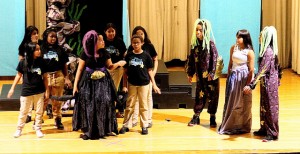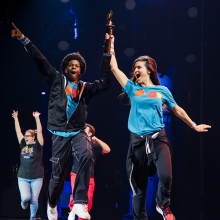Filichia Features: The Little Mermaid Jr. Gets an A+ at P.S. 161
Filichia Features: The Little Mermaid Jr. Gets an A+ at P.S. 161
 Photo by: Lauren Adler
Photo by: Lauren Adler
When parents come to the school where their child is enrolled, they’re usually prepared to hear bad news.
What’s she done now? How badly has he behaved? Am I about to meet teachers who’ll list multiple breaches of etiquette that will result in our kid’s getting suspended?
Maybe the best we can hope for is suspension. Perhaps we’ll instead hear that our child has committed a litany of atrocities that can mean nothing less than expulsion.
Jennifer Katona, the director of the graduate program in educational theater at The City College of New York, didn’t want that to be the scenario at nearby P.S. 161. “I preferred to have parents come to the school not because their kids were in trouble,” she says, “but because they were now in a show.”
So three years ago, Katona and P.S. 161 principal Pamela Price forged a relationship. City College’s graduate-student directors would stage musicals with sixth, seventh and eighth graders. The results were 35-minute TYA/Kids’ versions of Pinocchio (2011), The Jungle Book (2012 ) and Aladdin (2013). They went so well that Katona felt emboldened to make her 2014 entry the hour-long The Little Mermaid Jr. “And,” she says, “we’re doing scene and costume changes, which we’ve never attempted before.”
While the running time has almost doubled, student participation has increased more than twofold. “18 kids last year, 42 this year,” Katona says with understandable pride. Word has obviously spread among the students that doing a musical even after school -- despite all the effort, hard work and time that’s needed -- is great fun.
Katona hasn’t neglected an important component of producing educational theater. “We’ve conducted pre-show workshops for those who aren’t on stage. These students have been taught how to watch a show and how to be supportive of their classmates.”
And so on Thursday afternoon Dec. 11, hundreds of kids stormed their way into the school’s auditorium, giving out animated and loud chatter. They were clearly thrilled to leave behind reading, writing and arithmetic. But could these noisy kids be quiet once the show started?
Have you ever seen a group of students that hasn’t immediately gone silent once the house lights go down, the curtain opens and the stage lights come up? Once again, curiosity takes over and every eye faces the stage lest anyone miss anything.
Each ensemble member is clad in a handsome black The Little Mermaid Jr. T-shirt. And while of course some kids are more into performing than others, many are smiling broadly while making the effort to ensure that every word is understandable and that each dance movement counts. Most who have been entrusted with bolts of blue fabric that represent the ocean move them back and forth as precisely as possible to replicate the actual rhythm of waves. These kids are definitely part of this world.
P.S. 161 has already created a matinee idol. Ernest Rosario, who’s portraying King Triton, gets entrance applause. The gravitas he’ll reveal when playing the role will show that he’s entitled to it.
When he finally finds his missing daughter Ariel (the excellent Abriannie Rosario), he bellows at her “Where ARE you?!?!” The kids in the audience giggle in recognition; how many times have they heard their parents demand the answer to that same question? And yet, perhaps the musical’s message is landing: that parental concerns are not to be lightly dismissed and that seemingly well-wishing people may not have your best interests at heart. In the long run, you might be better off trusting your parents (at least in the vast majority of cases).
Ursula is played by Mariah Morales, and this Morales is something. Perhaps she’s never heard the long-held belief that playing a villain is the most fun a performer can have, but she instinctively knows it in both her heart and head. What delicious evil delight she displays when she sees her old enemy King Triton!
Morales’s powerful voice can reach the back row and might even be heard by those passing outside on West 133rd Street. She holds the last word of “Poor Unfortunate Soul” for many measures, which is quite the achievement given that the word concludes with a consonant. The young lady could handle any note, but she speaks-sings some of them to add texture in the best musical theater tradition.
Looking at the playbill got me to thinking about the 1961 and 1962 Chicago Cubs. That woebegone team chose not to have one manager, but instead hired eight coaches who’d rotate responsibilities. Similarly, this Little Mermaid had no fewer than 18 student directors and two choreographers, each of whom helmed a scene here and a song there.
“The school does not have full-time theater program,” says Katy Baker Cocovinis, one of the directors. She’s quick to acknowledge that everyone got by with a little help from Sobha Kavanakudiyil, a City College instructor with the program. What’s more, art teachers joined the graduate students in donating their time to build scenery and costumes.
The Cubs’ experiment went from bad (seventh place in 1961) to worse (ninth place and their poorest-ever record in 1962). Here, however, the multiple collaborators each wound up having a personal triumph with their kids. More than once I heard the kids sitting behind me say “That’s amazing,” “Wow!” and, needless to say, “Awesome!”
Every now and then, just before pianist Tyler Beattie finishes his vamp and reaches the beginning of the song, a performer gives a head thrust to indicate the confidence of “I’m ready to do this.” Ariel’s four Mersisters maneuver the modulation on “She’s in Love” with no problem at all.
The kids in the audience applaud and cheer early and often. But they aren’t always angels, of course. When Ariel gets cozy-comfy with Prince Eric (the stalwart Jalen Guichardo), the kids let out a salacious “Ooooooh!” Ditto when he and she dance for the first time. But the “Ooooooh!” that occurs when the now-human Ariel enters in a white cocktail dress is one of sheer admiration – partly because Rosario is accomplished enough to wear it with elegance.
And to think that this is just the final dress rehearsal prior to tonight’s official opening. In preparing for it, Katona didn’t just rely on previous years’ word-of-mouth, good as it’s been. “We’ve started Operation Fill-the-House,” she says. “We’ve put notices on the radio, got mentioned in Time Out New York and even made plans for a pot-luck dinner. As a result, we now have reservations for 150 – and there was a time when we got 35.”
Better still, a number of students who have gone through the program have become so enamored of singing, dancing and acting that they’ve decided to apply to Fiorello H. LaGuardia High School of Music & Art and Performing Arts. “The teachers have been asked to write a lot of recommendations,” says Lauren Adler, the program’s communications and marketing manager who served as a student director for last year's Aladdin. Says Katona, “We think many of the kids have a good chance of getting in.”
Herbert Espinal should apply. His performance as Sebastian the Crab is nothing less than astonishing. The kid knows just how much and how often to use his hands, making each gesture perfect down the last millisecond and quarter-inch. When he mulls over a serious thought, how perfectly he puts a hand over his mouth and pensively wiggles his fingers back and forth. Later when he must slide across the stage, he does with the speed and skill of a baserunner who’s never been thrown out.
Seriously, I’ve seen thousands upon thousands of performers on Broadway who don’t have the natural musical theater ability with which Herbert Espinal was born. If he ever needs a recommendation, he can certainly get one from me.
View all the photos!
 You may e-mail Peter at pfilichia@aol.com. Check out his weekly column each Tuesday at www.masterworksbroadway.com and each Friday at www.kritzerland.com. His new book, Strippers, Showgirls, and Sharks – a Very Opinionated History of the Broadway Musicals That Did Not Win the Tony Award is now available at www.amazon.com.
You may e-mail Peter at pfilichia@aol.com. Check out his weekly column each Tuesday at www.masterworksbroadway.com and each Friday at www.kritzerland.com. His new book, Strippers, Showgirls, and Sharks – a Very Opinionated History of the Broadway Musicals That Did Not Win the Tony Award is now available at www.amazon.com.




























